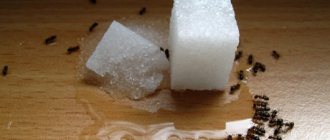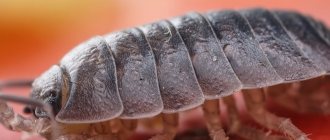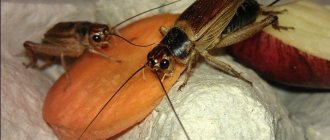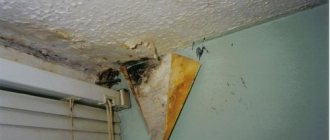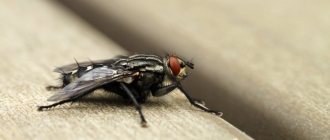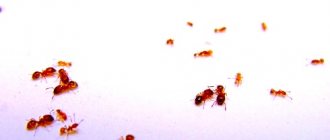Summer is rich not only in sun and warmth, but also in a variety of insects. In addition to the eternal struggle with mosquitoes, flies and bees, many have to decide how to get rid of crickets at home or in the garden. Insects rarely enter a room, but once settled in a house, they disturb the sleep and peace of residents by performing their nightly concerts. In addition, one female can lay up to 200 eggs, so if timely measures are not taken, soon there will be an orchestra of crickets in the house.
Crickets in the house cause serious inconvenience in the form of unsanitary conditions and loud trills at night. Ensuring a restful sleep can only be done by destroying or expelling the pest, which home remedies and chemicals can help do
You can deal with pests yourself. Chemicals, traps and folk remedies will come to the rescue. The article contains the most effective methods that will help get rid of insects and prevent their appearance in the house.
Description and features of the insect
The cricket, which lived in the desert climate of Asia and Africa, quickly spread across all continents.
Appearance
The length of the body of a bug with developed and strong wings does not exceed 2.5 cm. Insects have different colors, some individuals are very light, others have a dark brown tint. Of the three pairs of legs, the hind limbs are designed for jumping. The female cricket lays several hundred eggs, from which wingless larvae emerge. The insect lives up to 4 months and then dies.
How to recognize by sound
Warmth and food attract bugs to human homes. The monotonous trills emitted by crickets at night when they are awake are very annoying, but catching a moving insect is not easy.
How and why they sing
With sounds that prevent people from getting enough sleep, males lure females during the mating season and mark the boundaries of the territory so that the enemy does not lay claim to it. There are folds on the insect's wings that vibrate when they touch, producing a chirping sound.
What does a cricket look like, photo
Once insects become people’s neighbors in an apartment or house, everything changes. Not everyone likes the night trills, and in appearance the insects are more reminiscent of the less pleasant cockroaches.
The house cricket looks similar to the Prussian cockroach
The house cricket is a small insect. The body is slender, slightly flattened. It is covered by a hard shell ranging from grayish-yellow and straw-fawn to fairly dark shades of brown with specks, streaks and spots.
On the sides of the ovoid, flattened head are small eyes. Long antennae often exceed the size of the owner himself. The insect has well-developed wings. There are 3 pairs of legs. Thanks to the special structure of their hind legs, crickets can jump well. A characteristic feature of insects is the ability to produce specific trills and crickets.
Reasons for appearance
In the south, crickets are comfortable in natural conditions; in the northern regions and temperate latitudes, by the fall the bugs move to heating mains, basements, and spend the winter in houses and apartments.
Light
Although crickets sleep during the day, having found a secluded place, they become active at night, hunt for food, fight with enemies who have come to their territory, and bright light attracts singing insects to people’s homes.
See also
Instructions on how to make a rock garden with your own hands
Smell of garbage
Leftover food in a warm room quickly begins to rot; crickets, sensing a specific aroma, head to the place where the smell comes from, since they are not averse to eating spoiled food.
High humidity
Even insects that have lived for a long time in the desert regions of Asia and Africa, where it is dry and hot, with virtually no rain, strive to find moisture, and find it in basements and houses.
Open windows
Crickets easily crawl into microscopic cracks and open windows and doors attract curious insects.
Prevention
To ensure that crickets never return to your home, you must:
- carefully inspect all rooms and premises for cracks and other openings through which insects can get through and seal them properly;
- hang bird feeders on the porch and windows - they are natural enemies of crickets, and therefore the latter will avoid birdhouses;
- A compost pit located near your home may be attractive to these insects - it must be moved further away;
- It is advisable to change the bright light bulbs that illuminate the porch to less powerful ones - this will prevent the accumulation of crickets near your house at night;
- do not allow dampness to appear in the premises and try to always monitor the humidity level;
- crickets usually make their nests in thickets of grass, for this reason all climbing and tall vegetation growing in the immediate vicinity of the house must be removed - make sure that the lawn is always trimmed;
- Regularly clean drains and gutters of fallen leaves and other plant debris.
Thanks to these simple measures, your home and the area around it will always be clean and well-groomed, and therefore unattractive to crickets.
Methods of disposal
If the monotonous melody that is heard every night drives you crazy, a person forgets about the signs and dreams only that the singing will finally stop. However, annoying bugs sense even the slightest vibration in the air and hide in cracks where they cannot be reached.
Traditional methods
It is possible to cope with crickets without the use of poison and chemicals that are dangerous for household members. Since ancient times, people have known recipes to help remove insects.
Feed molasses and lemon balm
The bugs are not averse to eating food, they love sweets, but they are very fast and hide in a crack when they see a person. Crickets are lured by pouring molasses into a deep bowl. Insects will climb up there to taste the delicacy; bugs are unable to climb out.
Burning wax
The easiest way to determine the exact place that the candles have chosen is by the monotonous sounds made by the males. To force insects to leave the house, you need to light sealing wax near the crack where the uninvited guests have settled. The resins present in it are not tolerated by crickets.
Close all water sources
Insects usually settle in the bathtub or kitchen near the taps because they love moisture. Bugs feel uncomfortable in a dry room. Without access to water for a long time, they die.
Chemicals
If folk recipes do not give a positive result, and the crickets continue to irritate with their chirping, more stringent measures have to be taken.
Lures
When insects begin to multiply, pyrethrum powder, which can be purchased at a pharmacy, is poured into the places where they are most numerous. To lure crickets, place a saucer or plate of milk at the bottom of the container, into which sweet corn flakes are poured. Alcohol is poured into the upper compartment. The bugs will not refuse the treat, but will die from the fumes of the medicine.
Sticky strips
Adhesive tape helps to cope with crickets and annoying monotonous sounds. It is hung in different places in the house.
See also
10 ways to make your jeans fit a size smaller
Mechanical method
The safest way to kill a cricket is to hit the insect with any object at hand, but hitting a fast bug is not so easy.
Vacuum cleaner
To combat annoying guests, they use household appliances. Since insects crawl into crevices from which they cannot be removed, turn on the vacuum cleaner and pull the crickets into the filter under powerful air pressure.
Jar
People with a weakened psyche cannot stand the monotonous singing of a jumping insect and are trying to find a method that will get rid of the bugs forever. If the crickets have just appeared, upon discovering individuals, you need to cover them with a jar and then destroy them. When there are a large number of insects, neither adhesive tape, nor wormwood infusions, nor sweet traps are very helpful in dealing with the bugs.
Folk methods of struggle
After such a neighbor appears in an apartment or house, a person’s life changes. The insect starts its sonorous song exclusively at night and interferes with sleep. It is not always possible to catch a cricket at home, so there are many options for getting rid of the insect by fishing with bait or smoking. It is better to start using pesticides in radical cases; the treatment process cannot be called simple.
Attention! A single individual must be destroyed immediately after its appearance, otherwise the female will have time to lay eggs, and the process of struggle will drag on over time.
Sweet trap
To prepare the trap, you will need a deep container, which needs to be filled with a sweet, sticky mixture. It could be a mixture of sugar and water, molasses, fruit juice - this is the cricket's favorite food. It goes into the bowl at the time of eating. It often happens that the insect cannot get out of the sweet mass.
Plants
To repel insects, wormwood-based compounds are used. To prepare a solution with a volume of 1 liter you will need 2 tbsp. chopped leaves and stems. Boil the vegetable mixture for 5-10 minutes under a closed lid and remove from the stove. The cooled product is filtered and poured into a sprayer, the floor, baseboards, window sills and other hidden areas are treated. The product does not harm people or insects.
Adhesive tape
Using duct tape is the easiest method. It needs to be laid out in places where the insect is supposed to live, that is, in the area of baseboards, on window sills, in the bathroom. The disadvantage of this method is that it is unlikely that the cricket will be caught in the trap right away. The tape should be left for 24 hours.
Attention! The adhesive tape should be placed in the intended habitat and the room should be left for a day. If a person is present in the apartment, the technique will not produce results.
Sealing wax
Sealing wax is a fusible mixture with an intense odor that all insects dislike. To carry out such a manipulation, simply set fire to a small piece of sealing wax and fumigate the rooms with it. The product is not toxic to humans and domestic animals, but its effectiveness is comparable to new generation insecticidal preparations. For ease of fumigation, it is better to buy sealing wax in the form of a candle.
Trap pit
A trapping pit is a more complex and effective method that involves fishing with bait. To create a simulated pit, a container with two levels is required. It is placed on a bowl. For bait you need to take:
- cornflakes;
- sugar;
- milk;
- vodka.
A mixture consisting of sugar, cereal and milk is placed on the lower tier of the container, and alcohol is poured into the upper tier. The principle of the method is that the smell of sweets will attract the cricket, and the alcohol vapor will kill it. To create a trap using this method, you need to use medical alcohol with an ethanol content of at least 70%.
Vacuum cleaner
The option of catching with a vacuum cleaner can hardly be called successful. It is quite difficult to carry out an operation and catch an adult insect using household appliances, which is why the method is often used to get rid of insect eggs. A vacuum cleaner is used additionally after chemical treatment to collect dead individuals. It is important to immediately empty the collection container or bag, taking its contents away from the house.
Effective means to remove
The larvae are destroyed and adults are killed by chemicals, but they are also dangerous for people; when treating places where crickets accumulate, you need to wear gloves and ventilate the house well.
"Doctor Klaus"
The insecticide, produced in the form of an aerosol, copes with wasps and mosquitoes, flies and cockroaches, fleas and crickets. The drug contains active ingredients in the form of:
- synergist;
- lambda-cyhalothrin;
- stabilizer.
The spray is sprayed onto areas where insects are found. The product destroys both larvae and eggs.
"Dichlorvos universal"
Organophosphorus insecticide is sold in aluminum cans ranging from 180 to 500 mg. Aerosol is used to disinfect premises from parasites and insects with closed windows and doors. Spray the area from a distance of 20 cm, do not ventilate the house for 2 hours. "Dichlorvos" contains alkaloids, alcohol, cypermethrin.
The advantages of the insecticide include:
- low cost;
- lack of habituation of insects;
- speed of impact.
A medium package is enough to treat your entire home. The drug destroys all types of parasites.
"Tornado"
The insecticide is sold in plastic bottles in the form of a spray. When sprayed, it kills cockroaches, crickets, and spiders. When working with Tornado, you need to wear gloves and protect your respiratory tract with a respirator.
"Raid"
The aerosol is produced on the basis of organophosphorus compounds and acts on the insect upon contact. The insecticide penetrates the chitinous membrane into the body of the individual and paralyzes the nervous system.
Using a sprayer, the product gets into hard-to-reach places where crickets and bedbugs settle, and leaves no traces after use.
Natural Helpers
Birds that feast on these insects become selfless and active helpers in the fight against crickets. Starlings and tits are especially fond of bugs. To attract them, install feeders in the garden and replenish their contents regularly. Hedgehogs and grass snakes actively hunt for crickets.
To attract hedgehogs to your garden, use the following techniques:
- Plant bushes of lilac, rose hips, elderberry, spirea or deutia around the perimeter of the site. Hedgehogs willingly settle in such bushes.
- Make hedgehog shelters. They can be bought ready-made or made from baskets, boards, or any available materials. But make sure that the house has a long, narrow opening.
- Feed, especially in the fall, so that the hedgehog can settle down for winter hibernation. Dry food for dogs or cats is suitable as a treat. They love hedgehogs and milk.
Destruction of nests
To completely remove insects and prevent a secondary appearance, it is necessary to treat all cracks in the floor or walls, corners where crickets lay eggs, and get rid of the larvae.
What places should you check?
To find the nests of an insect that is annoying with its singing, it is not necessary to thoroughly study its habits or know the cycles and characteristics of reproduction.
See also
Selection of paint for white leather shoes and instructions for use at home
Basement inspection
In hot weather, crickets seek moisture and coolness. In multi-storey buildings there are plenty of areas in which candles feel comfortable. Service workers who are called for disinfection most often find cricket nests in basements.
Gaps in the house
Insects crawl into cracks in walls, floors, and settle in furniture. To find nests, you need to look under sofas, kitchen units, and into every crevice.
Skirting boards
Bugs that appear in an apartment or house begin to multiply and damage furniture and infest food and wooden surfaces. Crickets can be found under baseboards in cracks.
Methods of disposal
Having found insect nests, you should immediately try to destroy them yourself or call a worker from the service that disinfects premises.
Vacuum cleaner at maximum speed
A female cricket lays hundreds of eggs at a time, from which a new generation grows, which produces the next generation.
To destroy nests, you need to turn on the vacuum cleaner at full power and walk through cracks, cracks, and floors.
Specialist
It is more difficult to cope with crickets that have settled in a high-rise building than in a private house. To combat insect nests, in this case, a specialist is invited to disinfect basements, staircases, and treat places where parasites accumulate with special means.
Pet
Cats and dogs have a good sense of smell and often destroy the nests of birds and insects. By monitoring the pet's behavior, the owner can detect a gap inhabited by crickets and destroy them.
Treatment with a special spray
To force the bugs to leave the basement and crawl out from under the baseboards, spray a can of insecticide. Such products are produced in the form of aerosols and sprays and are convenient to use.
What harm do they do?
Crickets are omnivorous and cause enormous damage to garden plants.
In addition to the remains of human food, worms and small insects, the bugs eat leaves and root stems of plants.
They cause the most damage:
- strawberries;
- potatoes;
- corn;
- legumes;
- tobacco;
- wheat;
- rye;
- beans;
- beets;
- carrots;
- onion;
- tomatoes;
- cabbage
In terms of damage, a cricket invasion can be compared to its closest relative, the locust. These insects can leave a gardener without any hope for a harvest in a very short time.
In Asian and African countries, crickets are bred specially. These insects are eaten (their bodies are rich in calcium and protein). They even make chips from them.
Useful tips
Knowing the peculiarities of a cricket’s life, the question of how to get rid of them in a garden or apartment can be easily resolved. It will help to expel the bugs by reducing favorable conditions for their reproduction to zero.
Necessary:
- close all water sources, do not leave wet places, fix dripping taps;
- get a cat or dog, four-legged animals will eagerly hunt for insects and destroy their nests;
- use a powerful vacuum cleaner to go through all the cracks, pulling out the eggs of crickets and their larvae;
- close all the cracks in the house.
If you cannot cope with the bugs on your own, invite specialist disinfectors. SES workers will quickly free you from pests.
As for the garden area, it should also be kept clean. After harvesting, do not leave unnecessary objects on the ground - building materials, film, fallen leaves and other debris. When digging up your garden, take out all the excess – weeds and plant debris.
Life cycle
Male crickets establish dominance over each other through aggression. They start by hitting each other with their antennae and inflating their mandibles. If they do not retreat at this stage, they resort to fighting, each making sounds completely different from those heard under other circumstances. When someone wins, he sings loudly, the loser is silent.
Females are attracted to males by song. After mating, the female eats the spermatophore (the male's reproductive organ).
Eggs are laid on the soil, in plant stems. To do this, females have a long, needle-shaped ovipositor. Terrestrial inhabitants do without this, either placing the eggs in an underground chamber or pushing them into the wall of the hole.
The short-tailed cricket (Anurogryllus) digs a chambered burrow, lays its eggs in a pile on the floor, and feeds its young for about a month after the eggs hatch.
These are hemimetabolous insects - the life cycle consists of an egg stage, a nymph, which resembles the adult form, the adult. The egg grows into a nymph about the size of a fruit fly.
The nymph goes through about 10 stages, becoming more like an adult with each successive molt. After the last molt, the genitalia and wings are fully developed, but a period of maturation is required before the insect is ready to reproduce.
Chirping
Most crickets make a loud sound, stridulation. The stridulatory organ is located on the forewing, which has a leathery structure.
Find out more The largest insects on Earth
The calling song attracts females and repels other males, and is quite loud. The aggressive song is triggered by contact chemoreceptors on the antennae, which detect the presence of a rival.
Crickets chirp at different rates depending on the species and the temperature of the environment. Most chirps faster at higher temperatures (62 chirps per minute at 13°C.
The relationship between temperature and chirp frequency is known as Dolbear's law. According to this law, counting the number of chirps made in 14 seconds and adding 40 gives the temperature in degrees Fahrenheit.
Ground crickets (Nemobiinae) are wingless, others have small fore wings and no hind wings (Copholandrevus). Gryllus assimilis are efficient and good fliers, others are clumsy fliers.

